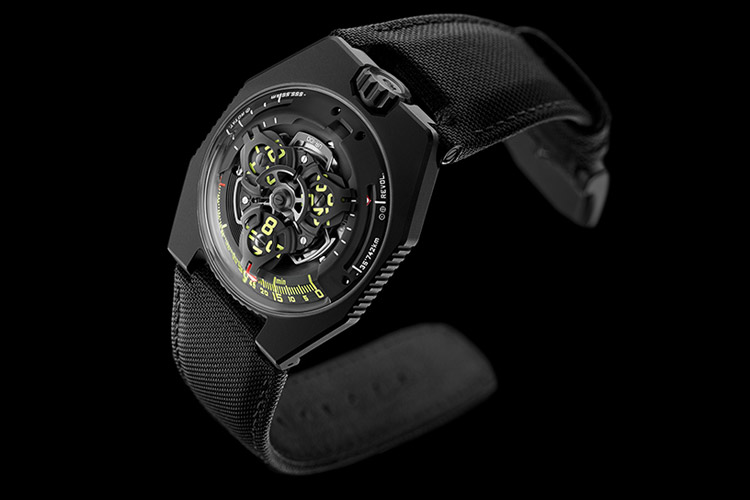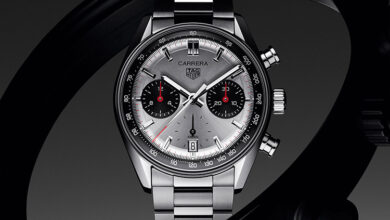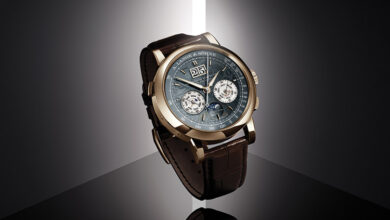
The UR-100 takes us on a journey through both time and space, two concepts at the very core of URWERK. Using its orbiting satellite hours and minute hands, the UR-100 displays both time (hours and minutes) and space (distance travelled), merging these two concepts in the creation of the all-new UR-100 SpaceTime
The UR-100 SpaceTime features URWERK’s iconic orbital hour satellites, differing however in one significant way. Rather than the red-arrow-tipped minute pointers on the hour satellites disappearing after 60 minutes when replaced by the next, the UR-100’s minute arrow passes beneath and between subsidiary dials, reappearing to display intriguing new astronomical indications: distance travelled on Earth and distance travelled by Earth.
Distance travelled on Earth
The first indicator at 10 o’clock evaluates the distance in kilometres that we have travelled on the Earth without even leaving our desks. It is based on the average speed of the rotation of the Earth on its axis at the equator, covering a distance of 555 km every 20 minutes.
Distance travelled by the Earth around the sun
Directly opposite at 2 o’clock, the same hand (it looks like the same hand, but is actually one of three) continues its journey to another celestial indication featuring the distance the Earth has travelled in its orbit around the sun – a journey spanning some 35,740 km every 20 minutes.
The UR-100 simultaneously presents three different space-time realities, providing a thought-provoking reminder of our voyage through time and space.
Caliber 12.01
Powering the UR-100 SpaceTime is the automatic Caliber 12.01, with baseplates in ARCAP and a power reserve of 48 hours. The automatic winding rotor is regulated by a flat turbine, the Windfäng (Swiss German for “air trap”) that minimises shocks to the rotor bearing and reduces over-winding and wear and tear. The rotor, which is partially supported on its periphery by the flat turbine, also has a larger diameter, resulting in a lower mass and therefore less wear.
In-house testing of the flat turbine rotor regulation system found that it provided significant and exponential protection against excessive rotor speeds (the Windfäng rotates six times for every rotation of the winding rotor).
The design and construction of the URWERK Caliber 12.01 required incredibly high precision because of the extremely tight tolerances between the minute hand and three different dials and domed sapphire crystal it passes between.
The shape of the case may remind URWERK aficionados of the aesthetics of the brand’s early watches. The case of the UR-100 is a deconstruction of an early URWERK case. The steel dome of URWERK’s historic models is reproduced in sapphire crystal. The form is emphasised by the titanium and steel case.
Genesis
The URWERK UR-100 was inspired by a nineteenth-century pendulum clock — a present to Felix Baumgartner from his father Geri, a now-retired renowned clock restorer — made by Gustave Sandoz for the 1893 World’s Fair in Chicago.
The regulator-style dial did not show time. Instead it showed the distance of the Earth’s rotation at the equator. The extra-long pendulum beat every 2.16 seconds, making every oscillation one kilometre. The main dial had a scale of 10,000 kilometres, shown in units of 100 kilometres, so that each tick (half oscillation) indicated 500 meters travelled on the Earth’s surface (at the equator). The top sub-dial (10 km) was divided into 10 units, while the lower sub-dial showed a total of 40,000 km — approximately the equatorial circumference of the Earth — divided into increments of 1,000 km.







